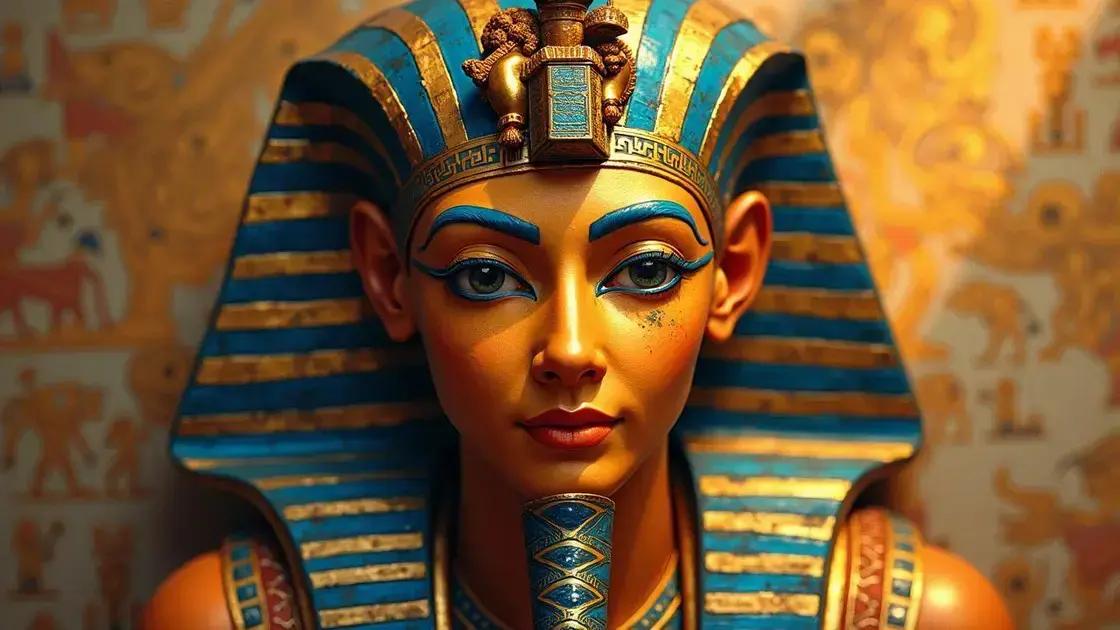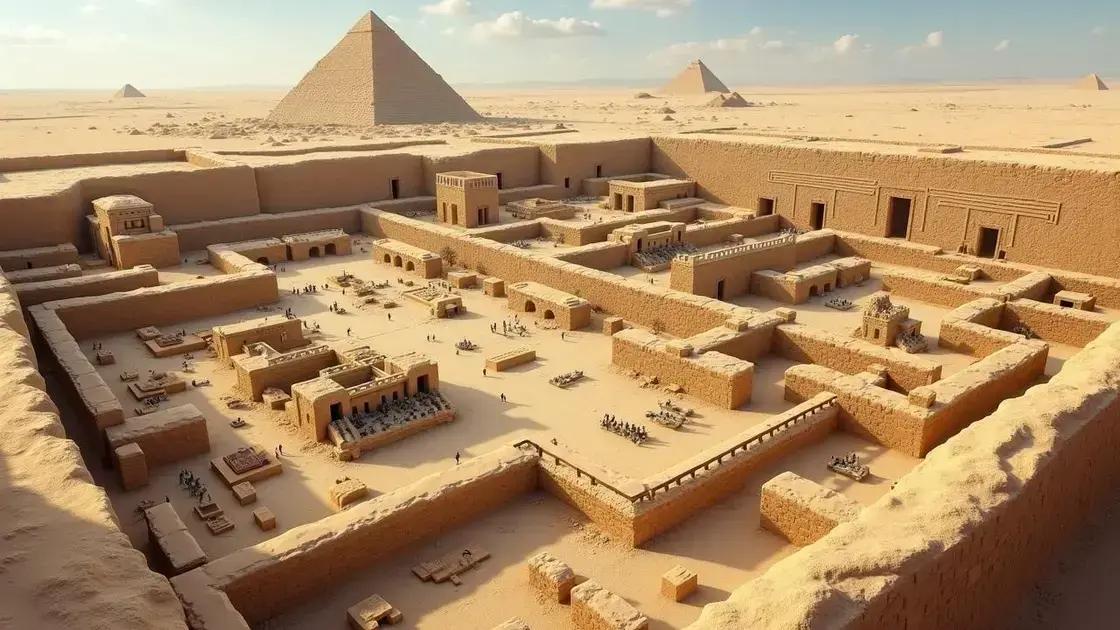The trick of the Egyptian Pharaohs, often surrounded by myths and legends, is backed by various historical records, archaeological discoveries, and cultural significance, revealing their strategic governance, clever tactics, and the moral lessons conveyed through their stories.
The question, “Is the Trick of the Egyptian Pharaohs backed by historical evidence?” invites curiosity about ancient mysteries and their truths. Many legends surround the magnificent Pharaohs, often leading us to wonder about the reliability of historical accounts. This article will delve into the myths, examine historical records, and explore archaeological findings to shed light on the cultural significance behind these stories.
Understanding the Myth of the Pharaohs’ Trick

The idea of the Pharaohs’ trick captures our imagination. Ancient Egypt was full of powerful rulers who are often depicted as wise and deceptive. The phrase “the trick of the Pharaohs” suggests a mysterious ability to outsmart others or achieve goals through cunning methods. Many stories about the Pharaohs have become legendary, leading us to wonder how much truth lies within these tales.
Legends and Stories
In popular culture, tales of Pharaohs using clever strategies to solve problems or escape danger abound. These legends contribute to the image of the Pharaohs as not only rulers but also as masters of trickery. Stories of elaborate schemes, like those seen in the tales of Thutmose III and his battles, highlight ingenuity in overcoming challenges.
Symbolism in Egyptian Culture
Understanding these myths requires looking at their symbolism. In Egyptian mythology, tricks can symbolize wisdom and knowledge. For example, the god Tehuti, often associated with writing and wisdom, represents this idea of cleverness. Thus, the trick of the Pharaohs can be viewed as a metaphor for their intelligence and strategies in governance.
Historical Context
History tells us about the political climate of ancient Egypt, which often necessitated cunning tactics. As Pharaohs ruled vast territories, they needed to manage threats from rivals and maintain control over their people. The tricks they employed could range from military strategies to diplomatic maneuvers, reflecting the complex nature of leadership at that time.
This context provides a deeper understanding of the term “trick of the Pharaohs” and allows us to appreciate the blend of myth and history in their stories. The fascinating interplay between reality and legend keeps the legacy of the Pharaohs alive even today. Exploring these stories opens the door to understanding the ingenuity of their rule and the lasting influence they have on history.
Historical Records: What Evidence Exists?

Many historical records help us understand the reality behind the trick of the Egyptian Pharaohs. Ancient Egyptian civilization left behind a rich collection of documents, inscriptions, and artifacts that historians study to uncover facts about their rulers. These records often reveal the way Pharaohs managed their kingdoms and dealt with challenges.
Inscriptions and Hieroglyphics
Egyptian hieroglyphics are a valuable source of information. Carved into walls of temples and tombs, these inscriptions often detail the Pharaohs’ achievements, military victories, and religious practices. Analyzing these texts helps researchers piece together their methods of governance and tactics used in conflict.
Historical Texts
Writings from ancient historians, such as Herodotus and Manetho, offer insights into the lives of Pharaohs. Herodotus described monumental constructions and the reasons behind those efforts. Manetho, an Egyptian priest, compiled a history that catalogs the reigns of various Pharaohs, outlining their accomplishments and events during their rule.
Archaeological Evidence
Excavations around ancient Egyptian sites continue to provide new evidence. Tools, weaponry, and everyday items found in tombs and temples contribute to our understanding of their life and tactics. For example, remnants of military equipment hint at battles fought by Pharaohs, showcasing their strategic thinking.
Additionally, the discovery of royal decrees on stone tablets illustrates how Pharaohs communicated with their subjects and maintained order. These records are essential for understanding the power dynamics and trickery employed in governance.
The Role of Religion
Religious texts and practices also reveal insights into the Pharaohs’ decisions. The belief in the afterlife motivated many rulers to manage their legacies carefully, often depicted in elaborate tomb paintings and inscriptions. These elements suggest that Pharaohs used cultural beliefs to their advantage, playing on the fears and hopes of their people.
Archaeological Discoveries and Their Impact

Archaeological discoveries have a profound impact on our understanding of the trick of the Egyptian Pharaohs. Excavations in Egypt reveal a wealth of information about their culture, governance, and strategies. Every artifact or structure uncovered provides clues to how Pharaohs ruled and influenced their people.
Major Excavations
Significant archaeological sites, such as the Pyramids of Giza and the Valley of the Kings, have provided vast knowledge regarding Pharaohs’ lives. These iconic structures not only showcase their architectural prowess but also signify their beliefs and the power dynamics of that era. Each excavation in these areas yields findings that relate to the Pharaohs’ rituals and their methods of maintaining control.
Artifacts and Their Significance
Numerous artifacts, including everyday tools, ceremonial items, and royal regalia, shed light on the complexities of daily life under Pharaohs. Tools found in tombs help illustrate the labor force needed to carry out grand projects, indicating how Pharaohs utilized resources and manpower. Additionally, items like scarabs and statues depict how they manipulated religious beliefs to consolidate their authority.
Analysis of Tombs and Burials
The examination of tombs provides insights into the rituals and beliefs of ancient Egyptians. The careful layout of tombs and the offerings within them demonstrate how Pharaohs used burial practices as a means to reinforce their divine status. These findings help experts analyze how Pharaohs perceived death and the afterlife, allowing us to appreciate the strategies employed to ensure their legacies endured.
Modern Technology in Archaeology
Modern technology plays a vital role in archaeology. Techniques such as ground-penetrating radar and 3D scanning reveal hidden structures and artifacts without disturbing the site. These methods allow researchers to uncover evidence more efficiently, leading to a clearer understanding of the tricks and strategies used by Pharaohs to enhance their reigns.
The Cultural Significance of Pharaohs’ Tricks

The cultural significance of the tricks of the Pharaohs can be seen in how these stories shaped ancient Egyptian society. The Pharaohs were not just rulers; they were often viewed as divine figures. Their tricks often served a larger purpose in maintaining control, fostering unity, and reflecting the values of their culture.
Symbol of Authority
Pharaohs used clever tactics to showcase their power and wisdom. This helped solidify their status as gods on Earth in the eyes of their people. For instance, when they executed unexpected strategies in battle, it promoted the idea that they were favorably guided by the deities.
Influence on Art and Literature
The legends of the Pharaohs’ cleverness influenced Egyptian art and literature. Many wall paintings and ancient texts depict stories of shrewd rulers who outsmarted their enemies. Through these artistic expressions, culture celebrated the cunning nature of their leaders, reinforcing the narrative of Egyptian strength and intelligence.
Morality and Lessons
Tricks often embodied moral lessons. Stories about Pharaohs outsmarting adversaries could serve as fables, teaching values such as wisdom, cunning, and the importance of clever thinking in everyday life. Such narratives instilled aspirations in the populace to be clever and resourceful.
Religious Context
The tricks of the Pharaohs were frequently intertwined with religious beliefs. They would conduct rituals or utilize clever strategies that reflected their devotion to the gods. This connection not only reinforced their authority but also created a sense of unity among the people, as everyone was involved in worship and revering their divine leaders.
In conclusion: Understanding the Legacy of the Pharaohs’ Tricks
Exploring whether the trick of the Egyptian Pharaohs is backed by historical evidence leads us to a rich tapestry of culture, strategy, and myth. From significant archaeological discoveries to historical records, each element unveils layers of complexity in how Pharaohs ruled and maintained their power.
The cultural significance of these tricks reflects not only in ancient stories and art but also in the moral lessons they imparted to society. The Pharaohs’ cleverness remains a testament to their ability to navigate challenges and cleverly influence their environment.
Thus, the legacy of these ancient rulers continues to captivate our curiosity, encouraging further exploration into their lives, their tricks, and their enduring impact on history and culture.
FAQ – Frequently Asked Questions about the Tricks of the Egyptian Pharaohs
What are the main tricks attributed to the Egyptian Pharaohs?
The tricks attributed to the Egyptian Pharaohs often involve clever strategies in governance, military tactics, and manipulation of religious beliefs to maintain power.
How do archaeological discoveries support the historical evidence of Pharaohs’ tricks?
Archaeological discoveries provide tangible evidence through artifacts, inscriptions, and structures that reveal the methods and strategies employed by the Pharaohs.
What role did culture play in the perception of Pharaohs’ tricks?
Culture played a significant role in shaping the perception of Pharaohs’ tricks, as they were often viewed as beyond ordinary rulers, symbolizing wisdom and divine favor.
Are the stories of Pharaohs’ tricks based on true events?
While many stories contain elements of truth, they are often embellished with myths that elevate the Pharaohs’ status and exemplify cultural values.
How do historical records contribute to our understanding of the Pharaohs?
Historical records from ancient historians, inscriptions, and religious texts offer insights into the rituals and governance strategies of Pharaohs, helping to validate the tricks attributed to them.
What is the significance of the Pharaohs’ tricks in modern times?
The tricks of the Pharaohs continue to captivate interest, allowing modern audiences to explore lessons of leadership, intelligence, and cultural heritage from ancient Egypt.












